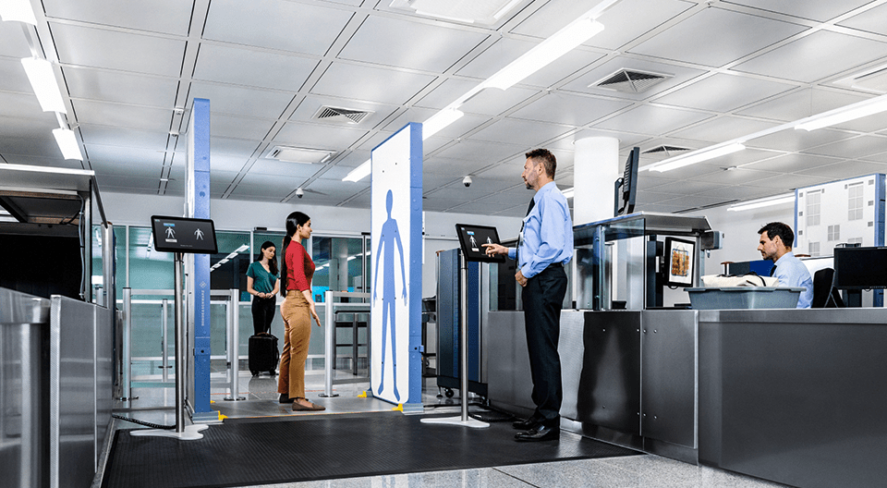Leveraging AI for People Screening: Millimeter Wave Tech and Deep Learning Can Produce Effective, Automated Virtual Searches


Despite advancements in security technologies across nearly every industry, options for screening people have largely remained the same for more than a decade.
People screening for loss prevention, data center security, high-value manufacturing, event security and other use cases generally relies upon low-tech and personnel-intensive measures like physical searches, pat-downs and metal detection systems. Some imaging systems that screen people use ionizing radiation or low-resolution terahertz imaging, which present health risks, lack sufficient resolution to detect items of interest, and sacrifice personal privacy. The performance challenges and staffing requirements of these legacy screening technologies have consistently undercut the business case for making investments to procure and operate.
However, the risks and costs of inadequate people screening are higher than ever. New threats and new security challenges require new high-performance tools that meet the expectations and operational needs of a wide range of applications. Combining high-resolution imaging technology with artificial intelligence (AI) and deep learning, emerging solutions are finally available to support high-fidelity people screening in security applications in a manner never before possible.
High-performance people screening systems using millimeter wave imaging technology has historically been used primarily in aviation security operations, where regulators, like the Transportation Security Administration, have well established detection, operational and functional requirements.
Outside of aviation security, use cases like event screening, asset protection and loss prevention have challenging requirements and urgent needs for tailored high-performance screening solutions. Ultra-high definition millimeter wave imaging systems are now available that can detect a wide range of threats and materials of interest to meet very specific security screening needs.
Security operations in many use cases and applications naturally present a variety of detection challenges based on the mission and desired security outcome. Whether screening for mass casualty threats like weapons and explosives, detecting high-value items to prevent theft, or finding small data-bearing devices or manufacturing prototypes to protect intellectual property, security decision makers have had limited technology options. With some vendors presenting extraordinary performance claims, it is important to understand the fundamentals of various detection technologies’ capabilities, as well as their limits.
Similarly, for security equipment manufacturers, it is essential to consider the varying requirements of these environments to ensure that products can be adapted to address specific security applications.
With collaborative and focused industry segment input, high-resolution millimeter wave imaging technology has proven that it can be adapted to meet specific mission needs and concepts of operation. Moreover, automated detection algorithms developed using AI and deep learning methodologies make it possible to detect application-specific items of interest.
High-performance millimeter wave technology utilizes automated detection software and algorithms to identify targeted threats, contraband and high-value items. Moreover, it eliminates the need for screeners to review raw images and ensures that the privacy of people being screened is protected. If the algorithms identify an item of interest concealed on a person, the security officer is presented with a representative human image, or an avatar, that identifies the location where the item was detected. The underlying raw image data analyzed by the algorithm is immediately deleted and overwritten as soon as the detection result is determined, typically less than three seconds.
In addition to addressing privacy concerns, automated detection algorithms reduce the burden on security operators and eliminate the time and challenge of relying on humans to perform image analysis and interpretation.
The combination of high-resolution image scanning and powerful automated detection algorithms gives operators new tools to tackle challenging applications like those in asset protection and loss prevention. It enables the ability to not only detect large concealed threats, such as guns and explosive devices, but also very small and thin objects like pharmaceuticals, USB sticks and SD cards.
Improving Security Effectiveness and Operational Efficiency
Previously, detection performance was limited to the ability of the human eye to spot anomalies and threats. The emergence of automated detection algorithms addressed some of the challenges screeners faced. However, with the higher detection provided by these algorithms came higher alarm rates, which affected security efficiency. Recent developments in AI and deep learning have enabled more effective targeted algorithms to be developed.
Regardless of the security application, effective detection algorithm software demands a high probability of detection and a low false or nuisance alarm rate. If the false alarm rate is too high, security operators may be required to conduct intrusive pat-downs, reducing the efficiency of the screening process and contributing to lengthy security wait times. New algorithms combined with high-resolution imaging systems support faster and more accurate screening in a variety of use cases.
Developing Fully Automatic Detection Algorithms
The development of automated detection algorithms typically relies on defining certain features of images, such as reflection, absorption, and edge effects of various materials when scanned by a millimeter wave imaging system.
Using these features, it is possible to establish parameters and size or detection thresholds for items of interest. For example, to train an algorithm to detect a gun in an image, one might begin by defining a feature or image refinement that enhances metallic objects, then configure the detection parameters so that, if more than a certain quantity of metal is present in an image, then the system triggers an alarm. If a user has an eight-color system versus 256 colors, the blended resolution is 32 times less, and, thus, the object to be detected must be significantly larger in size.
For gun detection databases to assess an image, one might consider creating a millimeter wave image library of all known firearms and then manually label them to define the detection features of the algorithm. While this seems like a straightforward approach, it can quickly become ineffective as new or unconventional firearms, such as 3D-printed “ghost guns,” are being developed all the time. Considering all the different types and shapes of dangerous objects, maintaining such an image database would present a daunting challenge.
The challenges of people screening in applications like loss prevention and asset protection are just as difficult, as security operators are tasked with detecting targets from secret prototype materials to high-value manufactured parts made of glass or plastics to packages of pharmaceuticals and expensive cosmetics.
Machine learning has been used to develop enhanced and specialized algorithms that do not need massive image libraries. This, along with other techniques, is helping to advance people screening technology.
From Machine Learning to Deep Learning
Machine learning has been widely used in computer security applications when one is asked to select images containing stoplights or bridges before gaining access to a system. Newer deep learning techniques are opening up many more possibilities.
Deep learning relies on a system of deep neural networks. Every node in the network is essentially a mathematical model of a neuron, similar to what is found in the human brain or central nervous system. Much like the development of the human brain, with deep learning, intelligence increases over time and can create new capabilities and continuous improvements.
To better understand the concept of an active deep learning system, one can think of a voice-controlled smart speaker in a house and the speech recognition software that learns the different voices giving it commands. Initially, the system might struggle to understand the various people that live in the home as it learns different pronunciations and accents. Over time, though, as the system continues to receive data – that is, the commands from various voices – its deep learning capabilities allow it to improve the computations in its nodes – even to the point that it can identify the voices of specific individuals. So, the next time you are at the store, your digital assistant can let you know who keeps adding chocolate bars to the shopping list.
These deep learning techniques can be developed with hundreds of layers and millions of parameters. To accomplish computations of these magnitudes just a few years ago required extremely powerful and expensive computer systems and hours of computation time. Today, these complex tasks can be performed much faster and more economically.
Conclusion
Combining deep learning techniques with imaging capabilities, coupled with databases of images of items of interest, means that rapid development of bespoke detection algorithms can be realized for very specific use cases and detection challenges. These range from screening people in various clothing types to enabling screening to be conducted in an environment where people are wearing face masks. Specific and optimized detection algorithms can be developed for narcotics and other contraband in border control applications or to enable the detection of data-bearing devices in data centers.
Choosing the right technology for people screening involves developing a detailed problem statement and defining the desired security outcome. Then security professionals can add effective people screening to their operations and leverage high-performance technology to address specific security challenges.
Christoph Baur (christoph.baur@rsa.rohde-schwarz.com) is the director of software imaging products at Rohde & Schwarz (rohde-schwarz.com).
